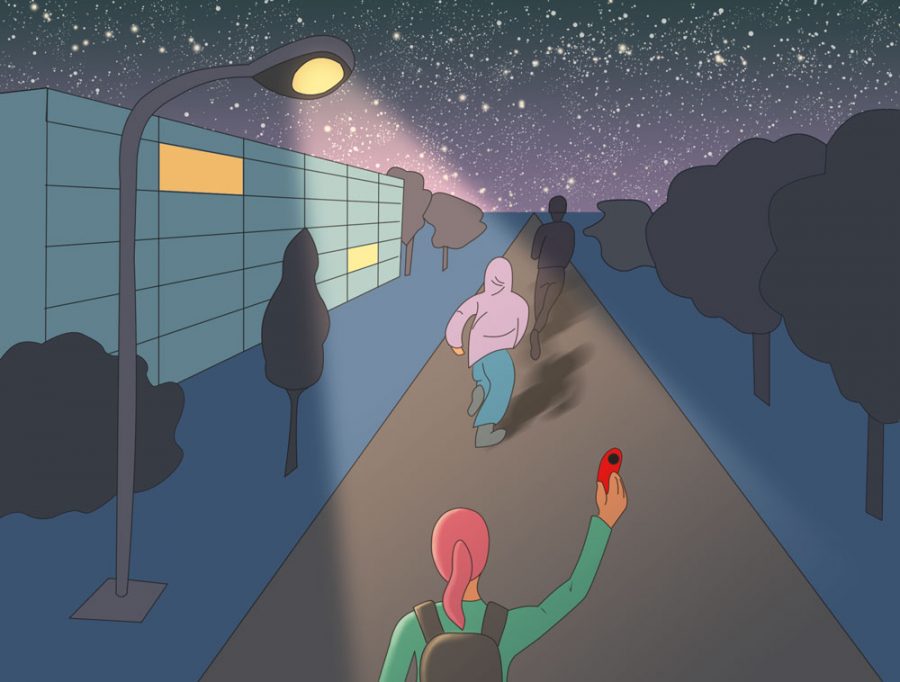East Bay students armed with personal alarms
September 28, 2016
Forget pepper spray: a USB drive-sized personal alarm system is becoming the new safety option on campus for students.
The University Police Department, in collaboration with ASI, and the Housing and Risk Management departments purchased 5,000 devices for the university — enough for the entire freshman class and more — according to UPD Lieutenant Omar Miakhail.
“This was not just a police initiative but really a partnership between several University Departments all focused on reducing crime and providing students with more tools to be safer both on and off campus,” said Miakhail.
The alarm, which was released by the Oakland-based start-up ROBOCOPP in Aug. 2015, is small enough to fit on a keychain, but at 120 decibels, is as loud as an ambulance siren, according to ROBOCOPP public relations director Jill Turner. ROBOCOPP maintains that it is the world’s smallest SOS alarm system, weighing in at less than an ounce, and has challenged customers on its website to find a smaller, lighter and louder alarm. This claim has gone uncontested, according to Turner.
The idea is that if a student finds themselves in a dangerous situation, they can pull the black pin at the top of the device and the ear-splitting alarm will scare off the threat while attracting help, Turner explained.
If the pin is not reinserted, the alarm will sound continuously for 30 minutes. The device is water resistant, childproof and if unused, the battery will last for one year on standby. The pin can also be reinserted and the alarm used again.
A study done by the International Institute of Criminology in Montreal found that 68 percent of criminals flee the scene as soon as they hear an alarm.
Devices were handed out at the freshmen orientation on Sept. 20 and al Fresco on Wednesday and have been randomly distributed around campus by the participating departments, according to Miakhail.
At the time of publication, the Hayward UPD had 300 devices left after supplying the Cal State East Bay Concord campus with 200 or so, Risk Management is down to 1,000 and the other participating departments ran out, confirmed UPD Administrative Assistant Jessica Ramirez.
Miakhail said the goal is to be innovative when it comes to student safety. The alarms retail for an individual price of $15.99 on the ROBOCOPP website but Miakhail said the university received a discount since they were purchased in bulk. Each department paid for their own allotment.
Turner said that data shows that people typically prefer non-violent means of self-protection to weapons. “I think you’re going to see way fewer people using and thinking of pepper spray as their first go-to,” she said. “I don’t want to knock pepper spray — it saves lives and it’s a great tool — but we find that the majority of consumers and people we talk to want something that is non-violent and cannot be used against them.”
East Bay isn’t the only college to jump on the ROBOCOPP bandwagon. Turner said the device is used on over 100 campuses across the country, including several CSU’s and UC’s in California.
“East Bay is just a really forward-thinking campus,” said Turner. “It’s able to take action and spend the energy on crime prevention. There’s a lot to be said for that. I think they’ll set a good example for a lot of campuses.”
The University Police Department looked for something convenient and effective when considering the device as a useful safety tool for students, according to Miakhail.
“It’s all about making sure students are safe and have as much info as possible,” said Miakhail. “It’s just one more tool they can use.”
The miniature alarm is personalized with East Bay’s red and black school colors, the UPD phone number and a barcode to the East Bay’s Pioneer Guardian campus safety phone app, powered by Rave Guardian, which was deployed by the UPD last September, according to Miakhail.
The Pioneer Guardian allows users to set “timer sessions” for how long they predict a specific route will take when walking alone, across campus or any place they feel uncomfortable, according to the Rave Mobile Safety website. They can then select a friend, family member or even the UPD as a point of contact to be notified by phone if they don’t “check in” after reaching the destination.
A 2014 UPD crime report recorded one case of rape, two of domestic violence and two of stalking. Liquor law violations outnumbered all other crimes, with 113 reported cases.
Crime rates are relatively low at East Bay, however not all college campuses can say the same. One in five women and one in 16 men are sexually assaulted while at college, according to the National Sexual Violence Resource Center. Ninety percent of sexual assault victims at college don’t report the assault.
Miakhail said that other Cal State and local campuses have called to find out more about the item since its launch at East Bay. “It’s something different,” said Miakhail. “I don’t think there are any other campuses that have an item like this.”
Based on the feedback and popularity of the device, Miakhail said they will be restocking again in the near future. The alarm systems are available at the UPD and free for all students with a Bay Card.

















